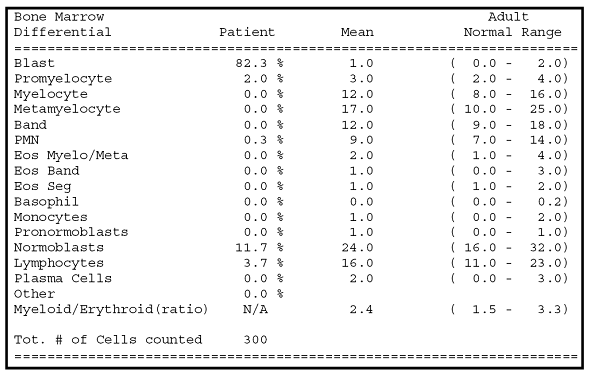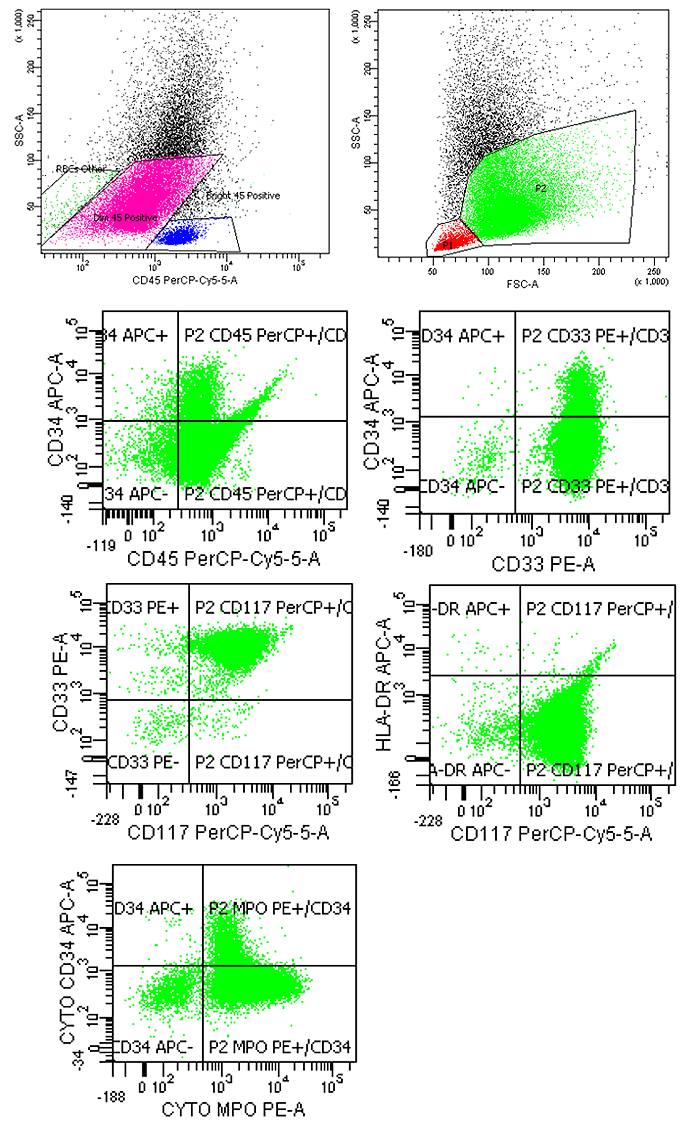
![]() Contributed by Kelly Garner, MD and Raymond Felgar, MD, PhD
Contributed by Kelly Garner, MD and Raymond Felgar, MD, PhD
CLINICAL HISTORY
Patient is a 49 year old male who does not have a significant past medical history until he developed tooth pain. He was found to have tooth abscesses which were treated with antibiotics. A month later, he had his wisdom teeth pulled and experienced delayed healing and persistent pain. He then began to feel fatigued, weak, and dyspnea on exertion, prompting a visit to his primary care doctor. Laboratory studies revealed pancytopenia resulting in a bone marrow biopsy.
Peripheral Blood:
The results of the CBC are illustrated in table 1 and revealed pancytopenia.
Table 1: CBC Data

The peripheral blood smear was reviewed and demonstrated a markedly leukopenic specimen with rare cells that were suspicious for leukemic cells (Figure 1 and Figure 2).
Bone Marrow:
The aspirate smears were adequate for interpretation. The bone marrow differential demonstrated numerous blasts (approximately 82%) with the remainder of the count illustrated in table 2.

The blasts by morphology had bilobed nuclei some with multiple prominent Auer rods (so called faggot cells) (Figures 3, 4, 5, and 6).
The bone marrow biopsy was adequate for interpretation and was hypercellular for age (90% cellular) (Figure 7). The biopsy also showed an increase in bilobed and promyelocytic cells (Figure 8), some with again multiple prominent Auer rods (Figure 9). Rare lymphoid clusters were identified and consisted of predominantly T-cells with an admixture of B-cells, by immunohistochemical stains. The myeloid/erythroid ratio was not evaluable by morphologic assessment, but appeared to be increased. Erythroid maturation was complete and the myeloid maturation was difficult to assess. Scattered megakaryocytes were present.
Cytochemical Stains:
A myeloperoxidase cytochemical stain was performed on the bone marrow aspirate which showed the cells of interest were strongly positive (Figure 10).
Flow Cytometry:
Flow cytometric studies performed on the bone marrow demonstrated a leukemic cell population with increased forward angle light scatter and 90-degree angle light scatter (side scatter) comprising approximately 78% of the total events with the following phenotype:
The leukemic cell population is highlighted on CD45 vs. side-scatter (pink/maroon color) and on forward vs. side-scatter plots (green). Antigen expression on this population is subsequently shown in plots based on light scatter gating (green, P2, population).
Figure 11: Selected Flow cytometry Histograms

Fluorescence In-Situ Hybridization Studies:
FISH analysis for translocation (15;17) was performed using probes to the PML1 gene (red) and the RAR-alpha (RARA) gene (green). A fusion signal demonstrates the presence of a t(15;17) fusion in 74 of the 165 interphase cells examined (Figure 12). Classical cytogenetics also demonstrates the presence of a t(15:17) (Image 13).